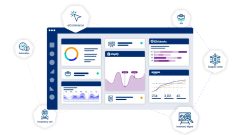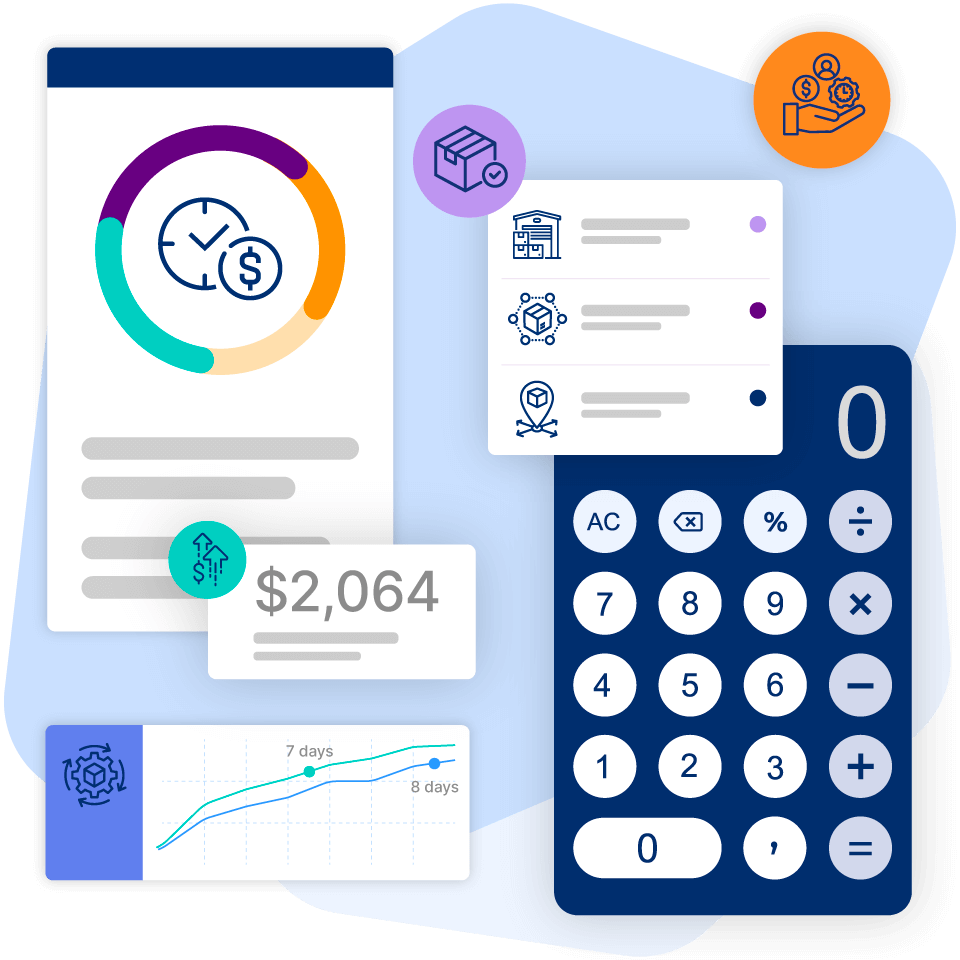
We know tariffs are top of mind for SMBs right now, whether you're navigating cost increases, rethinking sourcing, or just trying to stay compliant. That’s why we sat down with a panel of trade and supply chain experts for our recent webinar, Taxed and Confused: Making Sense of Tariffs. We took your biggest questions and broke them down into real talk, actionable advice, and a few helpful metaphors (because let’s be honest, tariffs aren’t exactly light reading). Below, you’ll find the highlights from that conversation, plus bonus resources to help you plan smarter and ship smoother.
How Do I Look Up Current Tariffs by HTS Code?
Start with the U.S. Harmonized Tariff Schedule (HTS). It’s the official source for up-to-date tariff rates by HTS code, updated regularly and searchable by product.
But that’s just the starting point, especially when some products have exemptions. There are several other tools that can help you go deeper:
- CBP CROSS rulings – Real-world classification decisions from U.S. Customs that show how similar products have been treated.
- Avalara’s Tariff Code Classification – A user-friendly tool that can help automate classification and flag potential exemptions.
- Platforms like Flexport and Descartes also offer advanced trade compliance features with alerts and historical insights.
Because when it comes to importing, surprises are best left for birthdays—not your duty fees.
What is Tariff Engineering?
Tariff engineering is the practice of designing a product—or how it’s packaged—so that it qualifies for a lower import duty. It’s 100% legal, as long as it’s done before the product enters the country and follows U.S. Customs and Border Protection (CBP) rules.
This might mean:
- Changing the materials or composition of a product
- Adjusting how it’s packaged
- Assembling part of it in a lower-tariff country
The key? Being transparent If it looks like you're trying to game the system, CBP won’t be amused. But if you're optimizing your operations within the rules, it’s just smart business.
Are Businesses Renegotiating Supplier Pricing to Reduce Tariff Costs?
Yes—and it can make a real difference. Many businesses are working with suppliers to restructure commercial invoices and remove non-dutiable charges like administrative fees, quality inspections, and freight from the dutiable value of goods.
When these costs are clearly itemized and separated from the product value, you can reduce your overall tariff exposure. But it has to be done by the book. Removing non-dutiable charges is only effective if it’s properly documented and compliant with customs regulations.
This is where a good customs broker or trade compliance specialist comes in. They’ll help ensure your invoices are structured correctly—so you're optimizing costs without raising any red flags.
Want a deeper dive into what counts as non-dutiable? This KPMG Guide breaks it down.
Should I Adjust My Business Strategy for Tariffs, Even If Things Might Change Again Soon?
It’s a fair question—tariffs can be unpredictable. But instead of building your entire strategy around today’s policy, it’s smarter to build systems that help you respond to change, whatever the cause.
Think of it like this: tariffs aren’t the only curveball your business might face. Natural disasters, shifts in demand, or supplier disruptions can be just as impactful. That’s why many businesses are moving toward flexible forecasting and scenario planning—some even build out “tariff scenarios” in their planning tools.
Here are a few ways to stay prepared without overhauling your entire operation:
- Use contingency sourcing to avoid relying on one region or vendor
- Adopt modular procurement so you can scale up or down quickly
- Build agile inventory policies that give you room to pivot
- Add tariff buffer zones into your cost projections to absorb impact without chaos
Bottom line: The goal isn’t to guess what’s coming next—it’s to be ready for it.
How Should I Handle Tariffs In My Landed Cost?
The best practice is always including tariffs in your landed cost calculation. That’s how you get accurate visibility into margins and cost of goods sold (COGS)—and how you avoid underpricing your products without realizing it.
Now, when it comes to pricing strategy, you’ve got options:
- Some businesses markup the full landed cost (tariffs and all) to keep it simple and preserve margins.
- Others add tariffs as a separate surcharge so they can maintain base price optics or meet contract requirements.
Are Tariffs Applied to Every Order or Is It More Complicated Than That?
Tariffs aren’t tied to orders—they’re tied to shipments. That means every time goods physically enter the country, they’re assessed based on the current tariff rate at that moment.
Think about it like this:
You and a friend both buy the same product from a store. Same price, same everything. But on your way out, there’s a toll booth at the parking lot—let’s call it a “tariff booth.” You go through first and pay $1. Two minutes later, your friend follows and the toll’s gone up to $2.
Same product. Different timing. Different costs.
So, if you're importing frequently, each shipment can be impacted differently—even if the product stays the same. That’s why having systems that help you track landed costs and update pricing quickly is essential. Spoiler: Cin7 can help with that.
How Do I Handle Tariffs When It Comes to Selling Price vs. Inventory On Hand?
All businesses handle pricing strategy differently—and when tariffs are involved, there’s no one-size-fits-all approach.
If you know a tariff is coming, it’s common to increase prices in advance, especially if your stock levels are low and you expect to replenish at a higher cost. Even if your current inventory wasn’t subject to the new tariff, your next batch will be—which impacts your margin.
Here are a few ways businesses manage that:
- FIFO-based pricing: Pricing reflects the cost of the oldest inventory first. If your current stock was purchased before a tariff hike, pricing may not reflect the higher replacement cost—unless you adjust.
- Blended margin approach: Costs are averaged across both pre- and post-tariff inventory to keep pricing more stable.
- Advance notice: Some businesses alert customers ahead of time when prices are set to rise due to incoming, higher-cost inventory.
- SKU-level averaging: Tariff costs are spread evenly across a product line to avoid sharp price swings and keep things simple.
You might choose to apply the tariff increase only to new inbound stock—or you may decide to raise prices across the board to protect your margins. Either way, make sure your inventory management system (IMS) or enterprise resource planning system (ERP) is set up to track when inventory was received and apply pricing logic accordingly.
The bottom line? Modeling matters. Before you update your prices, run the numbers.
How Do I Incorporate Tariffs into Inventory Accounts Instead of P&L?
Great question. If you’re capitalizing tariff costs (rather than expensing them), you’ll want those charges to flow into your inventory valuation—not hit your profit and loss statement directly.
Here’s how you can handle that in Cin7:
- You can add tariff costs as part of your landed cost using purchase order fields or set up automation rules to capture them consistently.
- From there, your general ledger mapping ensures those costs are allocated to inventory, not your P&L.
Where Can I Learn More About Tariffs, Inventory, and Global Supply Strategy?
We thought you’d never ask.
We pulled together a growing list of webinars, guides, blogs, and reports that have helped us and our customers navigate the world of inventory, supply chains, and global trade. It’s not just about tariffs—it’s everything from forecasting to fulfillment, and it’s especially useful if you’re managing operations across multiple regions.
Check out the full list below:
Trade & Tariff Lookups
- U.S. Harmonized Tariff Schedule (HTS)
- U.S. Customs and Border Protection Rulings (CROSS)
- General Trade Updates – CBP
- HTS Code Lookup Tool
- Avalara Tariff & Trade Center
- HS Codes List (U.S. International Trade Administration)
Webinars, Guides & Blogs
- Tariff & Trade Tuesdays by Avalara
- How to Prepare for Tariffs from Avalara
- Cin7 Blog: Inventory and Supply Chain Insights
Youtube Channels & Podcasts
- B2B eCommerce Insights
- B2B Bites Podcast by BigCommerce
- Hard Truth About B2B with Isaiah Bollinger
- Global Shipping Tips from WGOW Shipping
- Khan Academy: Global Trade & Tariffs
Tools for Small Business Operations
- Workflow Automation (No Coding Needed) from Zapier
- Spreadsheet AI for Non-Excel Experts from FormulaBot
More from the blog
View All Posts
Guide to Manufacturing for SMBs and How Cin7 Can Streamline Production and Increase Profitability
Read More
How Cin7 Helps SMBs Manage Tariff Costs
Read More




